what roll forming machines and dies are?
Roll forming machines and dies are essential tools in modern manufacturing processes. Roll forming machines use a continuous process to shape metal sheets into complex and intricate profiles, while roll forming dies are used to create the shape and profile of the finished product.
The importance of roll forming machines and dies lies in their ability to create a range of profiles in a variety of metals, including steel, aluminum, and copper. These profiles are used in various industries, including construction, automotive, and aerospace, to create a range of products such as roof panels, pipes, and structural beams.
The advantages of using roll forming machines and dies in manufacturing include their ability to produce high volumes of precise and consistent shapes, reducing the need for secondary operations such as punching and cutting. Roll forming machines and dies are also highly automated, allowing for faster production times, reduced labor costs, and improved safety. Additionally, they can produce profiles with high strength-to-weight ratios, making them ideal for lightweight applications.
Overall, roll forming machines and dies are crucial tools in modern manufacturing, offering a range of advantages and benefits that can help businesses meet their production needs more efficiently and effectively.
Common issues with roll forming machines and dies
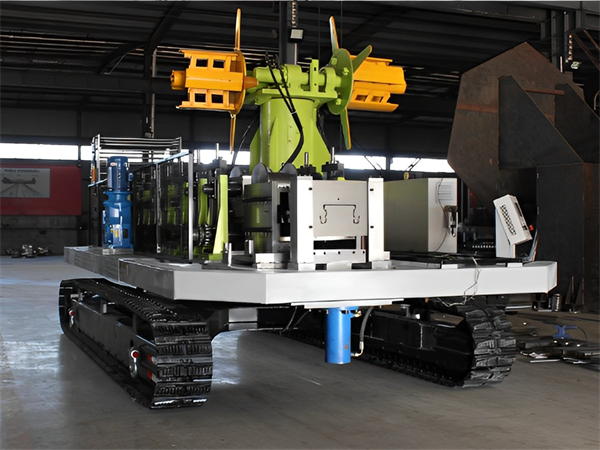
Roll forming machines and dies are used in the metalworking industry to shape long strips of metal into various shapes and sizes. These machines are highly efficient and productive when functioning properly, but they can experience a range of issues that can impact the production process. Here are some of the most common issues that can occur with roll forming machines and dies, along with their symptoms and impact on production:
Material buildup: Material buildup occurs when the metal being processed accumulates on the surface of the rollers or die. This can cause uneven material thickness, which can impact the accuracy and quality of the final product. Material buildup can also cause the machine to slow down, resulting in reduced production speed.
Tool wear: Roll forming machines and dies are subject to wear and tear over time. As the tools wear down, they can become less precise and less effective at forming the metal. This can lead to dimensional accuracy issues, such as variations in the size or shape of the final product. Tool wear can also cause the machine to produce excess scrap or require more frequent tool changes, which can slow down production and increase costs.
Misalignment: Misalignment occurs when the rollers or die are not properly aligned with each other. This can cause the metal to be formed incorrectly, resulting in dimensional accuracy issues or defects in the final product. Misalignment can also cause excessive wear on the tools and machine components, which can lead to increased maintenance and repair costs.
Dimensional accuracy issues: Dimensional accuracy issues can occur for a variety of reasons, including material buildup, tool wear, and misalignment. These issues can result in products that are not within the desired tolerances, which can impact the quality of the final product and may require additional processing or rework.
The impact of these issues on production can be significant. Material buildup, tool wear, and misalignment can all slow down the production process, reducing the output of the machine and increasing costs. Dimensional accuracy issues can also impact production by requiring additional processing or rework, which can further slow down the process and increase costs. In addition, these issues can impact the quality of the final product, which can have a negative impact on customer satisfaction and the reputation of the manufacturer.
Causes of roll forming machine and die issues
-
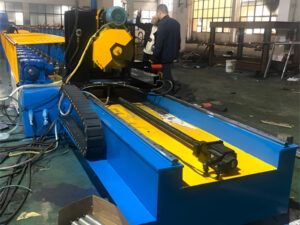 Joint Rack steel beam roll forming machine
Joint Rack steel beam roll forming machine -
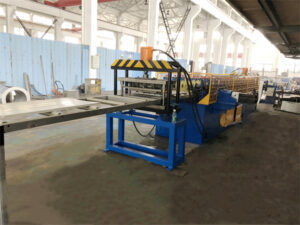 shelf panel roll forming machine for metal steel racking back
shelf panel roll forming machine for metal steel racking back -
 6 Sides Upright Racking Step Beam Welding Machine
6 Sides Upright Racking Step Beam Welding Machine -
 Laser welding racking step beam roll forming machine
Laser welding racking step beam roll forming machine -
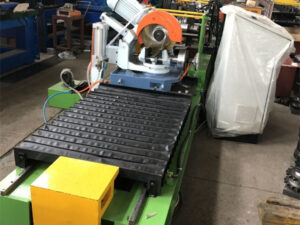 box beam roll forming machine for Steel Shelf racking
box beam roll forming machine for Steel Shelf racking -
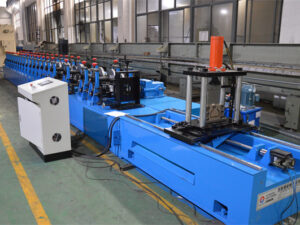 Upright racking roll forming machine for Heavy Duty Column
Upright racking roll forming machine for Heavy Duty Column
Here are some possible causes of the issues that can occur with roll forming machines and dies, along with how these causes can lead to each issue:
Material buildup: Clean the rollers or die regularly to remove any accumulated metal or debris. Ensure proper lubrication and use the correct lubricant to reduce the likelihood of metal sticking to the rollers or die. Cleaning the rollers or die regularly will help prevent the buildup of material on the surface, which can lead to dimensional accuracy issues and reduced production speed. Proper lubrication will help reduce friction and prevent metal from sticking to the rollers or die.
Tool wear: Regularly inspect the tools for wear and replace them as needed. Use the correct type of tooling and ensure that it is set up properly to prevent excessive wear. Regular inspection of the tools and replacement as needed will help ensure that the machine is able to form the metal accurately and efficiently. Using the correct type of tooling and setting it up properly will also help prevent excessive wear and minimize the risk of dimensional accuracy issues.
Misalignment: Regularly inspect the machine components, such as the bearings and shafts, for wear and replace them as needed. Ensure proper setup of the machine, including correct alignment of the rollers and die. Regular inspection and replacement of worn components will help ensure that the machine is able to operate correctly and reduce the risk of misalignment. Proper setup of the machine, including correct alignment of the rollers and die, is essential to ensure that the metal is formed to the correct shape and size.
Dimensional accuracy issues: Use high-quality materials that are consistent in thickness and hardness. Ensure that the machine is set up properly and that the tools are in good condition.
Regularly inspect the final product for dimensional accuracy issues and make adjustments as needed. Using high-quality materials and ensuring proper machine setup and tool condition will help minimize the risk of dimensional accuracy issues. Regular inspection of the final product will help identify any issues and allow for adjustments to be made as needed.
In summary, resolving issues with roll forming machines and dies involves regular inspection and maintenance of the machine and tools, as well as proper setup and use. By following these best practices, manufacturers can help ensure optimal performance and minimize the risk of production issues that can impact product quality and customer satisfaction.
Overall,Roll forming machines and dies are highly efficient and productive in the metalworking industry. However, they can experience various issues, such as material buildup, tool wear, misalignment, and dimensional accuracy issues. These issues can impact the quality and accuracy of the final product and reduce production speed. The causes of these issues can include improper tooling setup, material properties, and maintenance practices. Regular inspection and maintenance of the machine and tools, proper setup and use, and the use of high-quality materials can help resolve these issues. By following these best practices, manufacturers can ensure optimal performance and minimize the risk of production issues that can impact product quality and customer satisfaction.
